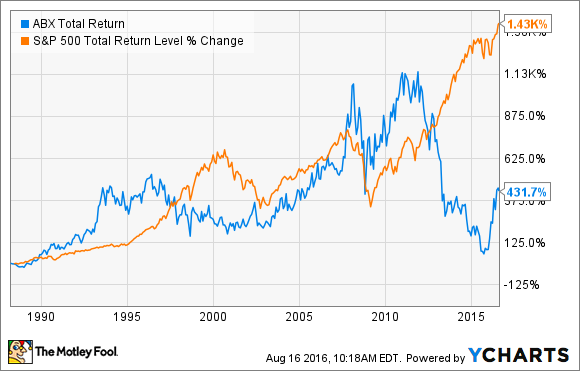
Image source: Getty Images
Investing in dividend stocks can be a great way to grow wealth over time, but it takes buying the right kind of dividend stock to make it work. Companies overburdened with debt, overly reliant on commodity prices, or not adjusting to market factors can quickly make a dividend evaporate into a cloud of dust. There are two companies and one entire industry with dividend paying stocks that I simply can't get behind with my personal investment dollars. Here's why they won't be on my investing radar any time soon.
The value isn't worth the digging
I can understand that many investors want some sort of exposure to precious metals to hedge against the ups and downs of the market. However, one dividend investment I just can't get behind is gold miners. In terms of a low cost producer, Barrick Gold (GOLD -1.88%) is probably one of the best in the gold mining business, but even using it as the best case scenario in the precious metals industry doesn't look that appealing.
One thing that makes gold miners such a tough investment to swallow is that their revenue is wholly dependent on commodity prices like other miners or oil and gas producers. Having that dependency on prices makes a company's income and cash flows extremely volatile, but it's even more difficult to determine the underlying demand factors. After all, less than 2/3 of annual gold is consumed in markets such as jewelry or industrial use. The rest is simply held as an investment vehicle that can have wild swings in inflow and outflow.
If the supply and demand market for gold wasn't hard enough to completely comprehend, there is the fact that there is an immense amount of risk involved in being a mining company. It's a capital intense business that requires taking on quite a bit of debt and is at risk of operational and regulatory hazards that could severely hamper production.
When you consider these risks, Barrick's paltry dividend of 0.38%, and its track record of losing handily to the S&P 500, it hardly seems worth the risk to invest in even what is possibly the best miner in the business.
ABX Total Return Price data by YCharts
Behind the times
Making steel is a tough business in the US. Not only is it a commodity product, but it's also one of those industries that built out massive capacity over the past decade to satisfy China's immense appetite for steel. Now that China economy is shifting gears, there is immense overcapacity in the steel making industry. So much so that the US has imposed anti-dumping tariffs on steel imported from a half dozen countries as of late.
If this backdrop wasn't tough enough to deal with, domestic steel manufacturer US Steel (X 0.92%) also has to confront another tough challenge; several of its competitors have beaten it down the cost curve. Thanks to investments in more advanced steel making techniques and a cost structure that is able to more rapidly respond to the market, competitors such as Nucor (NUE 0.38%) have been stealing market share for years and have pushed prices down so much that US Steel can barely turn a profit. It also doesn't help that the company has a high debt load that makes turning a profit that much more tenuous.
Steel is one of the essential products we need for development, but not all companies in the industry are guaranteed bets. With a paltry dividend of 0.9%, it hardly seems worth trying to play a rebound in steel with US Steel when competitors such as Nucor can be long term buy and hold opportunities.
Too much spending, not enough revenue
As attractive as Teekay LNG Partners (TGP) 4.4% dividend yield and a stock price that is trading for less than tangible book value, the company financials suggest a company that is going to struggle under an immense debt load for several years to come and make it increasingly difficult to pay shareholders.
Just looking at the balance sheet today, we have a company that has a debt to capital ratio of 58% and a net debt to EBITDA ratio of 7.4x. These two numbers are already alarmingly high and should give any investor pause. What's even worse, is that the company has some large capital obligations over the next two years that will require it to take on even more debt.
Between now and 2018. Teekay will be on the hook for an additional $3.1 billion in spending to build new vessels, $3.0 billion of which the company plans to fund with new debt. These are obligations that will need to be taken on before new revenues come online. Adding that much debt over this short time-frame will make the company woefully overburdened with debt before a single dollar in revenue comes in the door from these new ventures. The only way to support this kind of debt load would be if its revenue and cash flow estimates are spot on and there are no market hiccups. The chances of that aren't great, and it makes this company's dividend look highly suspect.





